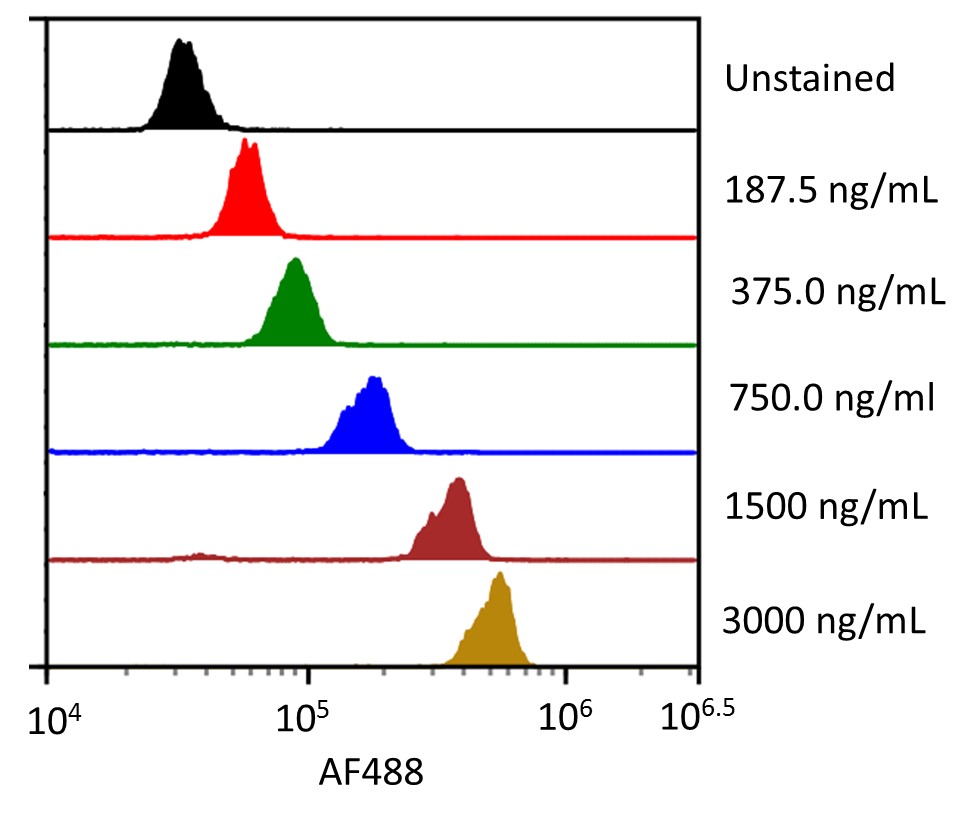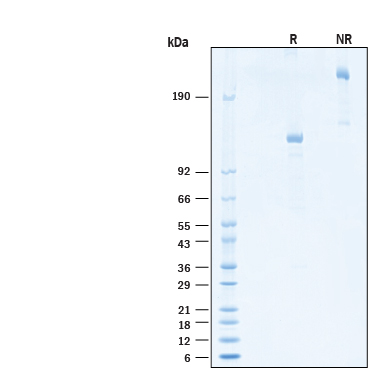Recombinant Human Siglec-2/CD22 Fc Alexa Fluor® 488 Protein
Recombinant Human Siglec-2/CD22 Fc Alexa Fluor® 488 Protein Summary
Learn more about FluorokinesTM Fluorescent-Labeled ProteinsProduct Specifications
| Human Siglec-2 (Asp20-Arg687) Accession # CAA42006.1 | DIEGRMD | Human IgG1 (Pro100-Lys330) |
| N-terminus | C-terminus | |
Analysis
Product Datasheets
AFG1968
| Formulation | Supplied as a 0.2 μm filtered solution in PBS with BSA as a carrier protein. |
| Shipping | The product is shipped with dry ice or equivalent. Upon receipt, store it immediately at the temperature recommended below. |
| Stability & Storage: | Protect from light. Use a manual defrost freezer and avoid repeated freeze-thaw cycles.
|
Scientific Data
 View Larger
View Larger
Streptavidin coated beads conjugated to biotinylated anti-human Siglec‑2/CD22 Monoclonal Antibody were stained with the indicated concentrations of Recombinant Human Siglec‑2/CD22 Fc Chimera Alexa Fluor® 488 (Catalog # AFG1968).
 View Larger
View Larger
2 μg/lane of Recombinant Human Siglec‑2/CD22 Fc Chimera Alexa Fluor® 488 Protein (Catalog # AFG1968) was resolved with SDS-PAGE under reducing (R) and non-reducing (NR) conditions and visualized by Coomassie® Blue staining, showing bands at 128-141 kDa and 256-282 kDa, respectively.
Reconstitution Calculator
Background: Siglec-2/CD22
Siglecs (sialic acid binding Ig-like lectins) are I-type (Ig-type) lectins belonging to the Ig superfamily. They are characterized by an N-terminal Ig-like V-type domain which mediates sialic acid binding, followed by varying numbers of Ig-like C2-type domains (1, 2). Eleven human Siglecs have been cloned and characterized. They are sialoadhesin/CD169/Siglec-1, CD22/Siglec-2, CD33/Siglec-3, Myelin-Associated Glycoprotein (MAG/Siglec-4a) and the identified Siglecs 5 to 11 (1 ‑ 3). To date, no Siglec has been shown to recognize any cell surface ligand other than sialic acid, suggesting that interactions with glycans containing this carbohydrate are important in mediating the biological functions of Siglecs.
Human Siglec-2, also known as B-cell antigen CD22 or B-lymphocyte cell adhesion molecule (BL-CAM), is a B-cell restricted glycoprotein that is expressed in the cytoplasm of progenitor B and pre-B cells and on the surface of mature B cells. Two distinct human Siglec-2/CD22 cDNAs that arise from differential RNA processing of the same gene have been isolated. The predominant Siglec-2/CD22 beta encodes an 847 amino acid (aa) polypeptide with a hydrophobic signal peptide, an N-terminal Ig-like V-type domain, six Ig-like C2-type domains, a transmembrane region and a cytoplasmic tail with 4 immunoreceptor tyrosine-based inhibition motifs (ITIMs) (4). The variant Siglec-2/CD22 alpha encodes a 647 aa polypeptide missing two Ig-like C2-type domains and has a truncated (23 aa) cytoplasmic tail (5). Siglec-2/CD22 is an adhesion molecule that preferentially binds alpha 2,6- linked sialic acid on the same (cis) or adjacent (trans) cells. Interaction of CD22 with trans ligands on opposing cells was found to be favored over the binding of ligands in cis (9). Besides its role as an adhesion molecule, Siglec-2/CD22 is a coreceptor that physically interacts with B-cell receptor (BCR) and is rapidly phosphorylated upon BCR ligation. It negatively regulates BCR signals by recruiting tyrosine phosphatase SHP-1 to its ITIMs. Phosphorylated Siglec-2/CD22 can also interact with other intracellular effector proteins such as Syk, PLC gamma, PI3 kinase and Grb-2, suggesting it may play a role in positive signaling (2, 7, 8).
- Crocker, P.R. and A. Varki (2001) Trends Immunol. 22:337.
- Crocker, P.R. and A. Varki (2001) Immunology 103:137.
- Angata, T. et al. (2002) J. Biol. Chem. 277:24466.
- Wilson, G.L et al. (1991) J. Exp. Med. 173:137.
- Stamenkovic, I. and B. Seed (1990) Nature 345:74.
- Kelm, S. et al. (1994) Current Bio. 4:965.
- Ravetch, J.V. and L.L. Lanier (2000) Science 290:84.
- Wienands, Y.J. et al. (1999) J. Biol. Chem. 274:18769.
- Collins, B.E. et al. (2004) Proc. Natl. Acad. Sci. 101:6104.
Product Specific Notices
This product is provided under an agreement between Life Technologies Corporation and R&D Systems, Inc, and the manufacture, use, sale or import of this product is subject to one or more US patents and corresponding non-US equivalents, owned by Life Technologies Corporation and its affiliates. The purchase of this product conveys to the buyer the non-transferable right to use the purchased amount of the product and components of the product only in research conducted by the buyer (whether the buyer is an academic or for-profit entity). The sale of this product is expressly conditioned on the buyer not using the product or its components (1) in manufacturing; (2) to provide a service, information, or data to an unaffiliated third party for payment; (3) for therapeutic, diagnostic or prophylactic purposes; (4) to resell, sell, or otherwise transfer this product or its components to any third party, or for any other commercial purpose. Life Technologies Corporation will not assert a claim against the buyer of the infringement of the above patents based on the manufacture, use or sale of a commercial product developed in research by the buyer in which this product or its components was employed, provided that neither this product nor any of its components was used in the manufacture of such product. For information on purchasing a license to this product for purposes other than research, contact Life Technologies Corporation, Cell Analysis Business Unit, Business Development, 29851 Willow Creek Road, Eugene, OR 97402, Tel: (541) 465-8300. Fax: (541) 335-0354.This product is provided under an agreement between Life Technologies Corporation and R&D Systems, Inc, and the manufacture, use, sale or import of this product is subject to one or more US patents and corresponding non-US equivalents, owned by Life Technologies Corporation and its affiliates. The purchase of this product conveys to the buyer the non-transferable right to use the purchased amount of the product and components of the product only in research conducted by the buyer (whether the buyer is an academic or for-profit entity). The sale of this product is expressly conditioned on the buyer not using the product or its components (1) in manufacturing; (2) to provide a service, information, or data to an unaffiliated third party for payment; (3) for therapeutic, diagnostic or prophylactic purposes; (4) to resell, sell, or otherwise transfer this product or its components to any third party, or for any other commercial purpose. Life Technologies Corporation will not assert a claim against the buyer of the infringement of the above patents based on the manufacture, use or sale of a commercial product developed in research by the buyer in which this product or its components was employed, provided that neither this product nor any of its components was used in the manufacture of such product. For information on purchasing a license to this product for purposes other than research, contact Life Technologies Corporation, Cell Analysis Business Unit, Business Development, 29851 Willow Creek Road, Eugene, OR 97402, Tel: (541) 465-8300. Fax: (541) 335-0354.
FAQs
No product specific FAQs exist for this product, however you may
View all Proteins and Enzyme FAQsReviews for Recombinant Human Siglec-2/CD22 Fc Alexa Fluor® 488 Protein
There are currently no reviews for this product. Be the first to review Recombinant Human Siglec-2/CD22 Fc Alexa Fluor® 488 Protein and earn rewards!
Have you used Recombinant Human Siglec-2/CD22 Fc Alexa Fluor® 488 Protein?
Submit a review and receive an Amazon gift card.
$25/€18/£15/$25CAN/¥75 Yuan/¥1250 Yen for a review with an image
$10/€7/£6/$10 CAD/¥70 Yuan/¥1110 Yen for a review without an image

